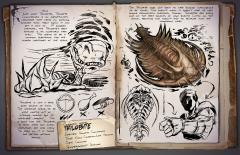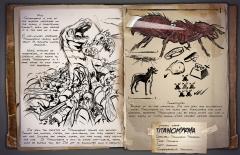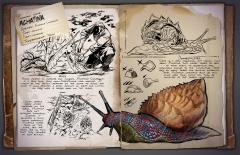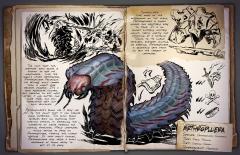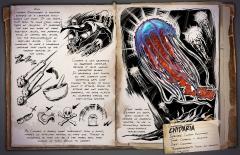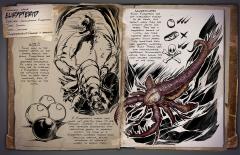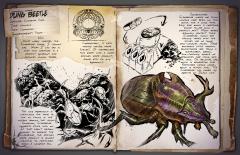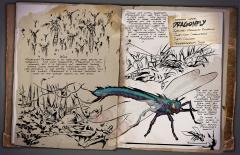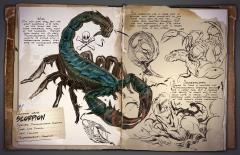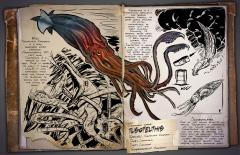Search the Community
Showing results for tags 'invertebrate'.
-
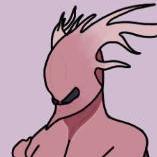
Shaihuludia Shurikeni - The gigantic wasteland worm!
Goredeus posted a suggestion in Creature submission archive
Yet again a creature vote crept up on me so no dossier this time! Shaihuludia is a gigantic worm that lives out in the wastelands on earth. to protect itself from harmful solar radiation wild Shaihuludia often cover themselves with various plants and minerals they find. occasionally they may get into an element node covering themselves in it protecting themselves from the corrupted but making them a target for daring survivors looking for element! When tamed Shaihuludia can be equipped with various heavy saddles due to its affinity with covering itself. Lightweight primitive saddle 1 rider 3 passenger seating with low defense can fully burrow Advanced saddle 1 rider 3 flak turrets offers great protection but turrets can only be controlled by passengers can partially burrow Tek saddle 1 rider 6 tek turrets great defense requires element to operate turrets can be controlled by rider and passengers grants flight it high element cost cannot burrow Controls Lmb - bite Shaihuludia everts it's pharynx using its jaws to snap in front of it dealing significant damage. Can be used to turn in place but has a longer wind up. Ctrl - burrow Shaihuludia burrows into the ground only exposing it's back and head. While underground Shaihuludia can move more quickly but uses more stamina. If Shaihulida uses a lightweight primitive saddle they will burrow underground completely. Shaihuludia cannot burrow with a tek saddle equipped. Space bar (underground, prim saddle) - lunge After a short delay Shaihuludia bursts from the ground into the air into a controlled fall. Deals extreme knockback and high damage to enemies as well as stunning fliers. If this attack kills an enemy Shaihuludia gains a health regen buff. Spacebar (tek saddle) - take off Enables Shaihuludias tek saddle thrusters allowing slow flight at a high element cost. Rmb (tek saddle) - fire Fires Shaihuludias tek turrets. Uses a hitscan laser projectile like Astrodelphis. Additional info Fossil and life reconstruction https://www.researchgate.net/figure/Reconstruction-of-Shaihuludia-shurikeni-gen-et-sp-nov-from-the-Spence-Shale-of-Utah_fig3_369899057 -
(Wildcard is censoring all mention of it’s name with sausage, keep in mind it’s real name is on the dossier, the L is to avoid censorship) When I was a young child, first getting into prehistory, I loved looking for the superlatives, the biggest dinosaur, the last mammoth, etc. But there was one that eluded me, the oldest. The dinosaurs lived a long time ago, yes, but reptiles are older, and fish older still. Eventually I was lead to the Cambrian and the explosion in life that many of our modern lifeforms can f trace there ansestors back to. But I still wanted older. Then I found it. A small group of organisms, called the Ediacaran biota, strange animals from many millions of years before the Cambrian. They were unusual, quilt-patterned animals that resemble ferns more than you or I, the tri-laterally symmetrical disks, and the largest of them all, the one-and-a-half metre Dlckinsonia. When I first read of these, little was know, were they even animals? Fungi? Some unknown experimentation of life? Nowerdays, they are nearly universally believed to be animals, but the much mystery remains. Many years later, I first booted up and played ark, I loved the game, and it would rapidly exceed all other of my games in playtime. I loved the game, as I adored prehistoric life. Only last year, I begun a playthrough on Aberration, while the last two votes ment less to me as I wasn’t on either Scorched Earth or Ragnarok during the vote. But because I was playing on Aberration, I have an idea of what creature I’d want on the map. Have you ever wanted to build a base where you shouldn’t? Perhaps near the fertile lake or in the more rural regions of the blue zone? Have you feared that nameless or reapers May spawn if your light pets ever run out of charge? Or been inconvinved by having to travel far to reach a charge node? Well I have a solution, the beast from long before all others aboard the ark, Dlckinosonia! Here’s a transcript of what was written on the soldier above: -Wild. I had long believed the trilobite was the oldest animal to be found, but while journeying beside through the lower parts of this broken ark, I found something much older. Dlckinsonia luxavora congregates around the bioluminescent -Domesictaed. I doubt Dlckinsonia has the brain power to be domesticated, but by taking advantage of it’s hunger, one can be lead to a more useful location. So, what use would this pose to you, as a survivor? Well I have two main ideas. First off, if you wanna make a base in the blue zone, you often need to fill it with glowtails and featherlights to prevent nameless from killing all your tames, I prepose Dlckinsonia would resolve this by acting as a standing charge source, giving off charge light permanently in a certain radius, with no need to recharge. Along with this, my concept includes the ability to function as a charge node, allowing you to fill up your batteries or craft element from your base. Finally, it would be able to accumulate oil in it’s inventory, helping ease the resource’ rarity on aberration, How would you tame such a beast? Well for this I prepose something similar to the beloved method of the troodon, you have to feed it your tames. But not just any tames, your light pets. This will cause it to rear up like shown on the dossier, giving it effectiveness when it kills them. Rinse and repete and you got yourself a anti-reaper carpet. As I know from the Dinopithecus wildcard loves to give creature submissions some usability for PvP, so I suggest possibly giving it bear trap/plant species R functionality, where a player walking near will be trapped and have to button mash to escape, giving the, use outside of aberration. To adresss some possible questions: Do you mean this to be an upgrade to/replace light pets? No, unlike lights pets, it is not pickupable by hand, and I intend it to be more of a base deafense/utility tame. Where would it spawn? I’m thinking it would spawn rarely around the blue lake, and more common around the crystalline lake deeper in the blue zone. Why should I pick this over the Reaper Emperor? It’s all up to, I am proposeing this to help take some of the lategame grind away from aberration, maybe not adding to much, but making it a more enjoyably experience.
- 4 replies
-
- abberation
- invertebrate
-
(and 4 more)
Tagged with:
-
From the album: Dossiers
Common Name: Trilobite Species: Trilobite Conchadurus Time: Early Cambrian-Late Permian Diet: Carnivore Temperament: Defensive Wild: Like most Trilobites, Trilobite Conchadurus is an opportunistic carnivore that feeds on anything smaller than itself which it can get a hold of. A sluggish creature, the Trilobite's best defense is its incredibly hard shell. This seems to be a common adaption for the slower creatures of the island. Trilobite is not a very good source of food. The creature seems to be made mostly out of internal organs and its defensive carapace. This is good for the Trilobite, as both river and ocean predators are less likely to prey on it if there are better options around. Domesticated: The Trilobite does not seem to have enough intelligence to be tamed. This doesn't mean it doesn't have its uses among resourceful survivors, though. Trilobites are easily one of the best sources of high quality chitin on the island, assuming one doesn't wish to venture into the dangerous caves. Known Information: Trilobite is not a very good source of food. The creature seems to be made mostly out of internal organs and its defensive Carapace. This is good for the Trilobite, as both river and ocean predators are less likely to prey on it if there are better options around. -
From the album: Dossiers
Common Name: Titanomyrma Species: Titanomyrma parvagigan Time: Paleogene Diet: Herbivore Temperament: Territorial Wild: Titanomyrma is one of the smaller creatures on the island; A frightening thought, when you realize it is the size of a dog. A hive-minded herbivore, Titanomyrma usually goes about it's business unless provoked. When attacked or threatened, it releases a chemical which alerts all Titanomyrma in a large range to help fight the aggressor. I've seen two varieties of Titanomyrma: Drones and soldiers. Drones are smaller, faster and land-bound, and they harvest for the hive. Soldiers are larger, slower and have wings; They defend the hive. If Titanomyrma is akin to other hive-insects, there must be Queens too, but I've yet to encounter such a variant. Domesticated: Because of its hive mentality, I've not seen any successfully tamed Titanomyrma on the island yet. Fortunately for lone survivors, separated Titanomyrma can be easily picked off for a small supply of Chitin among other valuable natural resources.- 1 comment
-
- titanomyrma
- ant
- (and 7 more)
-
From the album: Dossiers
Common Name: Achatina Species: Achatina Limusegnis Time: Holocene Diet: Herbivore Temperament: Passive Wild: Found mostly in marshes and jungles, Achatina Lumusegnis is a very slow, very non-threatening land mollusk. It might be the safest creature on the island to hunt, and while it only provides a small amount of meat and Chitin, An easy meal is always good on the island. Unlike nearly every other creature on the island, Achatina does not defecate normally. Instead, it secretes a thick, sticky substance. Achatina leaves trails of this slime, but the trails are so thin that they crumble to dust quickly. Domesticated: There is a very diguesting, but useful, fact about achatina that causes tribes to seek to tame them: its secretions are chemically similar to the 'cementing paste' used by many tribes for building materials. Tamed Achatina naturally build up this slime over time, which can then be collected at the tribe’s convenience.- 2 comments
-
From the album: Dossiers
Common Name: Arthropluera Species: Arthropluera Felsanguis Time: Early Permian Diet: Carrion-Feeder Temperament: Aggressive Wild: The fact that this creature exists is enough to give me nightmares. Like the island's other Arthropods, Arthropluera Felsanguis has become much larger than I might have believed possible. It's a very aggressive hunter, but prefers to eat meat after it has rotted for some time, and will voraciously seek out such delicacies. Arthropleura's blood has a very low pH, to the point that it can dissolve many materials. This acidic blood splashes back on anything that directly attacks it, weakening the durability of weapons and hurting attackers. Many creatures thusly refuse to prey on Arthropleura, fearing this unique defense. If that wasn't enough, Arthropleura also keeps a small reservoir of blood ready to spit at its prey. Domesticated: Like most of the arthropods on the island, Arthropleura is simple minded and relatively easy to tame. It is an almost entirely military mount, useful mostly for attacking at a distance. Thanks to its unique defenses, whether hunting or warring, Arthropleura is generally safe from all but the largest of creatures.- 2 comments
-
- arthropluera
- invertebrate
- (and 5 more)
-
From the album: Dossiers
Common Name: Spider Species: Araneomorphus amalgotantibus Time: No Equivalent, traits begin as far as Mesozoic Era Diet: Carnivore Temperament: Aggressive Wild: I don't know where to start with Araneomorphus amalgotantibus. It has so many of the nightmare inducing traits of spiders from among many family and genus. It fires webbing like a bola spider, it spits venom like a lynx spider. It has a poisonous bite like a myriad of spiders, and can see in the dark by sensing vibrations. And to top it off, Araneomorphus is larger than an adult human! If that wasn't enough, I'm convinced that some of the caves on the island have actually been dug by Araneomorphus, but this worries me. Either Araneomorphus is a colony-spider (like ants), or there is a much larger Araneomorphus somewhere on the island. Domesticated: As long as it is kept far from arachnophobics, domesticated Araneomorphus makes an excellent guardian creature for anyone wanting to avoid killing. Their strange web-spraying behavior is also quite helpful while hunting fast, fleeing prey. They are too small to be used as mounts, however...- 1 comment
-
- araneomorphus
- araneo
- (and 10 more)
-
From the album: Dossiers
Common Name: Cnidaria Species: Cnidaria omnimorph Time: Cambrian - Holocene Diet: Carnivore Temperament: Passive, but aggressive at close range Wild: Cnidaria omnimorph is another example of a creature which should not exist. It has traits that seem to come from many types of jellyfish. It possesses the size and shape of large egg-yolk jellies, the powerful sting of certain box jellies, and the bioluminescence of deep-sea jellies. This all combines to make a dangerous creature that lights up the deepest reaches of the ocean. Cnidaria is not generally an aggressive creature, because it lacks normal perceptive senses. it generally just floats on the current until something gets close enough to sense, at which point it attacks. While its attacks are not directly powerful, its sting injects an incredibly strong and fast-acting sedative. Most tribes kill Cnidaria on sight, then collect its reserve of powerful sedative, to use in technically advanced long-distance tranquilizers. Domesticated: As Cnidaria is barely more intelligent than a plant, there's no effective method to tame one. though dangerous as they can be, a few tribes even keep schools of them around to harvest.-
- cnidaria
- not tameable
- (and 8 more)
-
From the album: Dossiers
Common Name: Eurypterid Species: Jaekelopterus Euryperus Time: Silurian Diet: Carnivore Temperament: Aggressive if approached Wild: Found only in the deepest depths of the waters around the island, Eurypterids are dangerous and adaptable Arthropods. As likely to hunt as they are to scavenge, a Eurypterid rarely has difficulty finding food to keep itself nourished, even at the bottom of the ocean. A Eurypterid’s threat does comes not directly from its raw strength. Instead, it combines a hard defensive exoskeleton with debilitating poison to powerful effect. The sting of a Eurypterid increases torpor while reducing stamina, quickly rendering its opponent unable to defend itself. Domesticated: While Eurypterid are not intelligent enough to be tamed, this doesn't mean they are without utility for tribes. They are a wonderful source of Chitin, and their digestive tract often contain Silica Pearls. They sometimes even have incredibly rare Black Pearls used for manufacturing mysterious technologies, making them among the most valuable creatures on the island.-
- eurypterid
- invertebrate
- (and 7 more)
-
From the album: Dossiers
Common Name: Dung Beetle Species: Scarabidae Gigas Time: Holocene Diet: Coprophagic Temperament: Passive Wild: What magic created the Scarabidae Gigas, I cannot say. What I can say is that this creature is a perfect symbiont for advanced human tribes. Coprophagic, it eats mostly useless waste (feces). It metabolizes this waste into a more refined waste product, along with an oily byproduct. The oily byproduct is chemically the same as the oil found in the oceans around the island. Somehow, Scarabidae converts feces into oil. If that wasn't reason enough to worship the Scarabidae, the refined waste product is almost identical to fertilizer from a compost bin. Domesticated: Scarabidae makes me think humans have been on the island for a long time. Why else would a creature evolve to be such a perfect pet? Most tribes jealously protect their scarabidae, whom are handily tamed with the skilled use of some well-handled feces. These wondrous little organic biofactories are truly a sustainable, green, eco-friendly source of resources for living off the land. Oil becomes gas, which is generator fuel. Fertilizer means crops, which is human fuel. The scarabidae can power all aspects of island life!-
- dung beetle
- bug
-
(and 8 more)
Tagged with:
-
From the album: Dossiers
Common Name: Dragonfly Group: Invertebrates Species: Meganeura quatpenna Time: Late Carboniferous Diet: Carnivore Temperament: Docile Wild: Meganeura quatpenna is an especially large species of dragonfly. Actually, it is a type of griffinfly, an extinct species of invertebrate that looked similar to dragonflies. Like most griffinflies, Meganeura is carnivorous, but it is typically not aggressive towards humans unless provoked or challenged for food. It lives primarily in the wetter, heavily wooded areas, such as the jungles. Meganeura is a natural predator of most of the smaller insects on the island. Though not often aggressive, Meganeura will not turn down a free meal. They quickly appear in large numbers to scavenge off the victims of Pulmonoscorpius, rendered unconscious and unable to defend themselves. Of course the insects do have to avoid the Pulmonoscorpius itself. I have noticed it is unwise to disturb a flock of feeding Meganeura. The size of the insects on the island confounds me. The way these creatures diffuse oxygen should limit their size but Meganeura (and other bugs) seem to be able to advance beyond this restraint. If there is more oxygen in the air this could explain Meganeura's growth.-
- invertebrate
- meganeura
- (and 8 more)
-
From the album: Dossiers
Common Name: Scorpion Species: Pulmonoscorpius gigantus Time: Late Silurian Diet: Carnivore Temperament: Aggressive Wild: I'm not sure why, but the giant scorpions I've seen on the island are far more disturbing than most of the Dinosaurs. Rather than simply kill its prey, Pulmonoscorpius gigantus injects its victims with a tranquilizing poison, then eats its unconscious prey alive. This subspecies has a large pair of pincers that seem connected to the same toxin sacs as the tail. I've never seen another scorpion that has this adaptation, but I've never seen another scorpion that is larger than I am, either. Domesticated: Trying to tame a monster like Pulmonoscorpius gigantus sounds like a crazy idea, but I suppose the ability to knock out a foe could come in handy. It could certainly make incapacitating some of the island's other creatures much easier.-
- carnivore
- late silurian
- (and 8 more)
-
From the album: Dossiers
Common name: Tusoteuthis Vampyrus Time: Cretaceous Diet: Carnivore Temperament: Aggressive Wild: Tusoteuthis Vampyrus is a very aggressive predator. Approximately 30 feet long Tusoteuthis is a terror of the deep. Once it grabs its prey, it slowly crushes it into submission while using the talons on its tentacles to siphon and drain the victim of blood. Tusoteuthis is a terrifying opponent for several reasons. Firstly, its grab slowly renders its victim unconscious, so death isn't the first concern. Secondly, its vampyric blood drain instantly revitalizes it even during combat. And finally, if Tusoteuthis is losing a fight, it sprays a cloud of ink into the water around it, blinding its attacker to cover a sneaky escape. Domesticated: One of the major benefits of taming Tusoteuthis is harvesting its ink. Unlike normal ink, Tusoteuthis' ink is very oily, and can even be refined into fuels such as gasoline. Between that and the Tusoteuthis' distinctive combat abilities, it makes for an excellent aquatic tame despite slow swimming speed.-
- cretaceous
- tameable
-
(and 7 more)
Tagged with:

